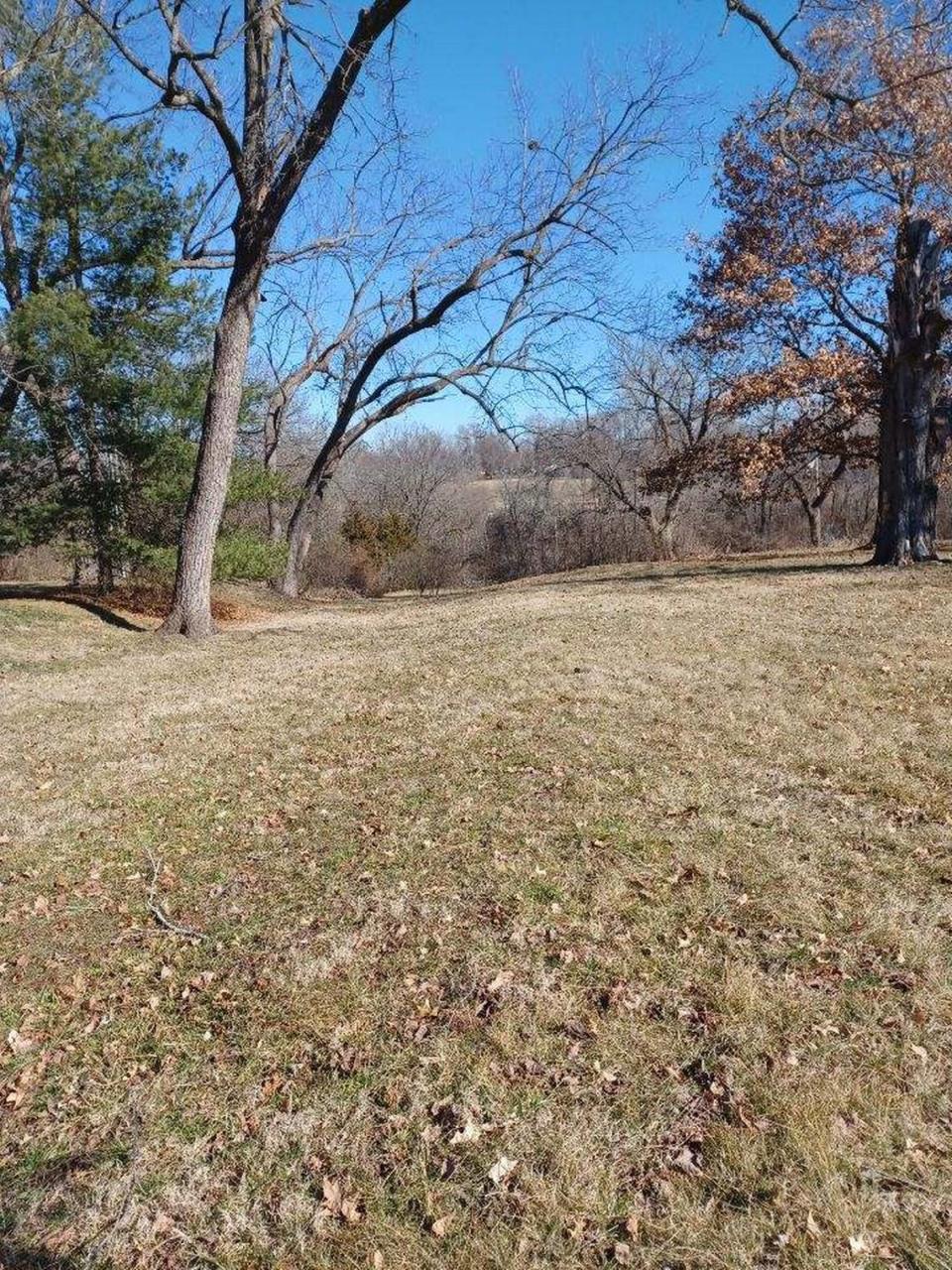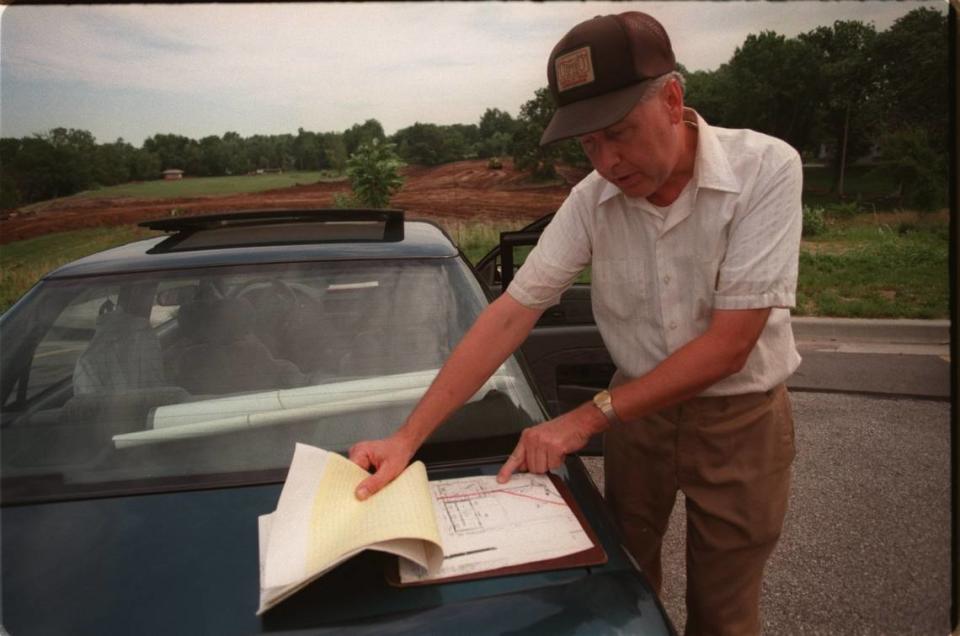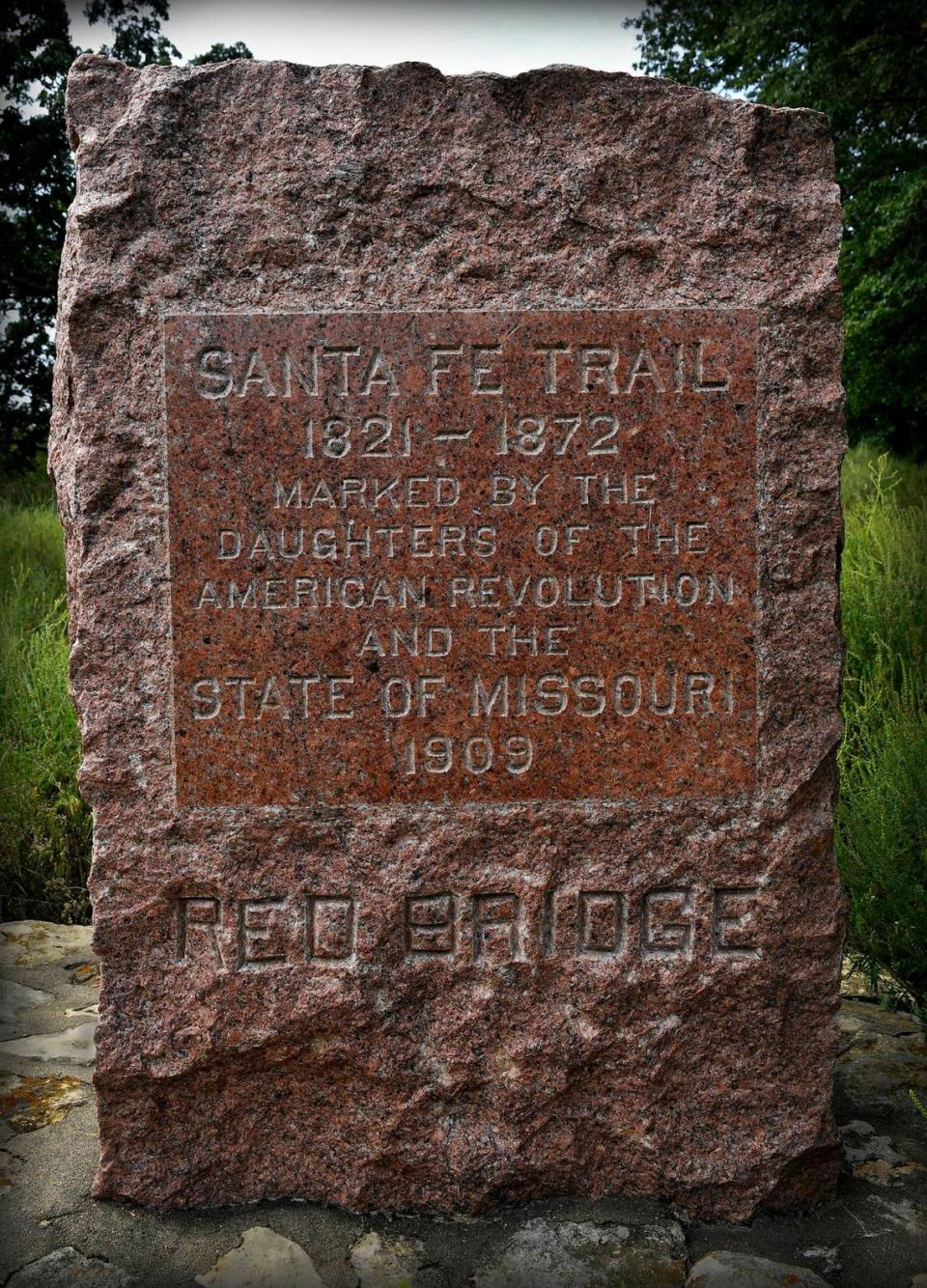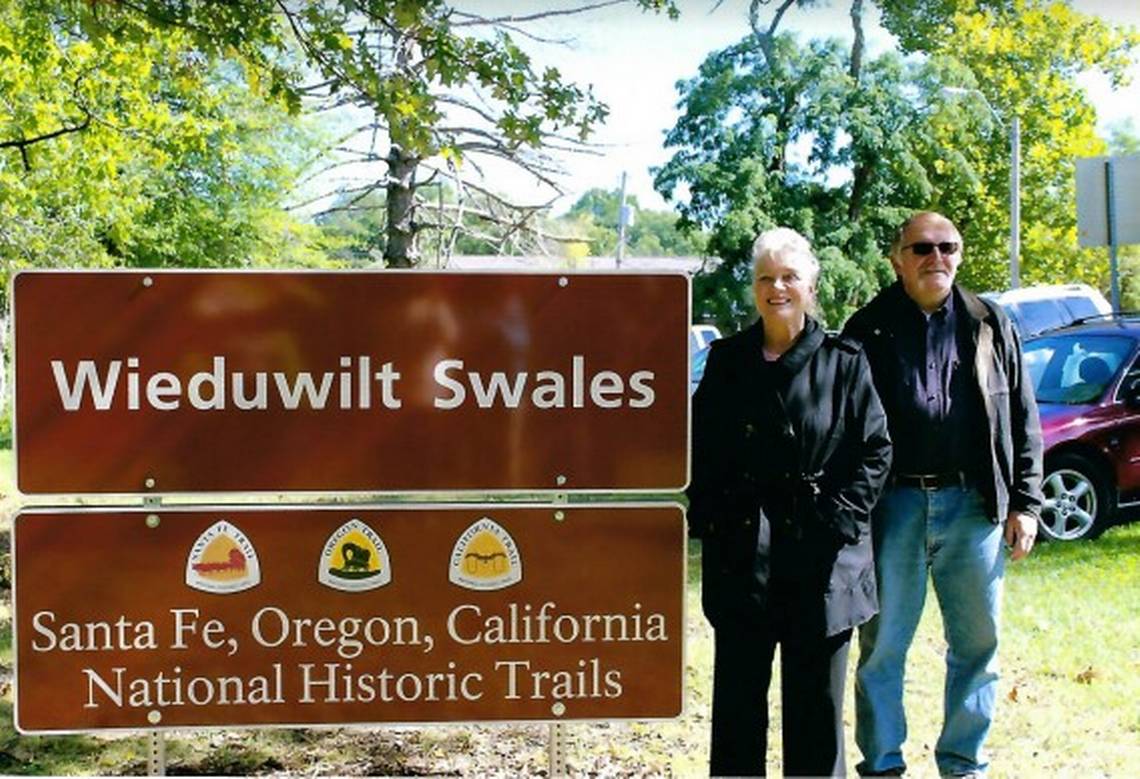What’s Your KCQ is a collaboration between The Star and the Kansas City Public Library series that answers your questions the history, people, places and culture that make Kansas City unique. Have a suggestion for a future story? Share it with us here, or email our journalists at KCQ@kcstar.com.
Hollywood loves making TV and movie dramas where the hero, usually an older adult with a healthy disdain for authority, stands up to The Man by planting himself or herself in front of heavy machinery that is about to wipe out a piece of history.
Well, that happened in Kansas City in 1998.
The man was trails historian Walter Cook, and the piece of history he sought to save was a remnant of the Santa Fe Trail in eastern Kansas City. As in all these scenarios, an intractable villain claimed our hero was standing in the way of progress.
In this case, however, the villain wasn’t a greedy corporation. It was a church — Blue Ridge Bible Church, to be precise, which wanted to plow under nearly 200-year-old Sante Fe Trail swales (ruts left by the wheels of freight wagons) and replace them with a soccer field.
Although Cook’s stand failed and the soccer field was built, nearby swales — now called the Wieduwilt Swales — survived. They are part of a web of remnants that trace the path of the Santa Fe Trail, which operated between 1821 and 1880, from Independence through Kansas City and into Kansas.

Which leads us to a question to “What’s Your KCQ?,” The Star’s ongoing series with the Kansas City Public Library that answers readers’ queries about our region:
Jennifer Franz of Greenwood asked, “Where did the name Wieduwilt come from for the Wieduwilt Swales?”
The answer is simple: They were named after Paul Wieduwilt and his wife, Sharon, who live on land adjoining the site.
But the backstory is complicated.
It turns out that Paul Wieduwilt, then headmaster of Blue Ridge Christian School, was among the voices opposing Cook’s heroic efforts in 1998.
“The land was unusable, just sitting there,” Wieduwilt told The Star at the time. “The school is growing, and we needed the room. We’ve got 500 students, and we needed another soccer field.”
He said that what Cook claimed was a Santa Fe Trail swale looked more like a drainage gully.
A quarter-century has changed Wieduwilt’s perspective, however. He regrets the stand he and Blue Ridge Christian took in 1998 and has even become something of a swale hero himself.
“We didn’t realize at that point what was there,” he said. “And it was done before we could do anything about it. We were in sort of an awkward place.
“We should have known better.”


The Wieduwilts still live on a 1-acre property adjoining the Wieduwilt Swales at 85th and Manchester, just west of Blue Ridge Boulevard. In fact, swales run through their front yard.
“We get people who come by and look at it quite often,” Wieduwilt said. “It’s not like they’re knocking down the door to see it, but there will be people come through and look at it.”
The site is technically a Kansas City park, although the city’s Parks and Recreation website makes no mention of it. Thanks in part to an agreement with the National Park Service, it features a stone marker and interpretive sign.
The Missouri River Outfitters Chapter of Santa Fe Trails Association sponsored a dedication ceremony in 2014 to officially name the site, which had been referred to simply as “85th and Manchester.”
“They asked if they could use our name,” Wieduwilt said, “and we said, ‘Yeah. That would be fine.’”
The Blue Ridge Bible Church and Christian School have been replaced by Grace Baptist Church and Carver Baptist Bible College, but the soccer field remains.
Wieduwilt mows his namesake site, saying the city does little maintenance there. But as a fan of the Santa Fe Trail, he doesn’t mind.
“We’ve got the books and maps and stuff,” he said. “We’ve thought about … following the trail all the way to Santa Fe by car and stopping at some of these places. And just experience the whole thing, since it’s been such a neat thing for us to have it right here.”


Cook has died, but fellow trails activist Larry Short, past president of the Santa Fe Trail Association and now chairman of its mapping and marking committee, recalls the 1998 incident.
“That Bible church there decided that soccer fields were much more important than preserving history,” he said. “We tried everything we could to work with them and negotiate, and even buy the land from them. They absolutely refused. They didn’t care about history of the swales or anything else.”
While not blaming Wieduwilt for the soccer-field decision, saying it was out of his control, he bemoans the loss.
“That was just a beautiful site,” he said. “You could stand up at the top and look down through the Wieduwilt Swales and across all the swales.”
The Wieduwilt site is among dozens of venues in the Kansas City area commemorating the Santa Fe Trail as well as the California and Oregon trails, which also began in Independence. Unlike those two, which primarily carried settlers heading west, the Santa Fe was a trade route, so the wagons drawn by oxen, mules and horses carried heavier loads and left the deep ruts that remain visible in many areas.
Short, who lives in Independence, is confident all the Santa Fe swales in the area have been identified, but you never know.
“We continually get calls from people claiming they’ve got swales going through their backyard,” he said. “Ninety-nine percent of the time they’re not actually swales. Most of the time they’ve been where they put a drainage pipe or something through.”
In any case, the Santa Fe, California and Oregon trails — celebrated with the annual Santa-Cali-Gon Festival in Independence — as well as the Lewis and Clark river route, make this area the nation’s hot spot for such things.
“That gives us more national historic trails than any other major metropolitan area in the country,” Short said. “I get a little bit excited talking about all the trails here. I love the trail history. And the impact it had on this area is just incredible. A lot of these things around here wouldn’t exist if it wasn’t for the trails.”
Short provided a brief area trails history:
The first Santa Fe Trail left from Franklin, Missouri, in 1821. Later, it left from Independence. The original Oregon and California trails left from Independence, following the same route to Gardner Junction in Kansas. Once Westport Landing opened in the 1840s, all three trails followed the Westport route to Gardner Junction. Later routes to Oregon and California would leave from Leavenworth and St. Joseph. These routes are not part of the routes approved by Congress as National Historic Trails.


Follow the trails’ swales
▪ Bingham-Waggoner Estate, 313 W. Pacific Ave., Independence: Across a ravine south of the home.
▪ Santa Fe Trail City Park, 2900 S. Santa Fe Road, Independence: About a quarter mile of ruts and swales.
▪ Wieduwilt Swales, 85th and Manchester: A certified site on the Santa Fe, Oregon and California National Historic Trails.
▪ Minor Park, off Red Bridge Road at East 110th Street: Site of the first river crossing for trail travelers.
▪ New Santa Fe Cemetery, off West Santa Fe Trail just east of State Line Road: Small swales are visible at what was once the final stopping point before leaving the United States.
▪ Lone Elm Campground, 167th and Lone Elm, Olathe: A city park includes the wagon trail corridor and campground where many trail travelers spent their first night west of Missouri.
▪ Harmon Park, 7727 Delmar, Prairie Village: On the trail from Westport Landing to Gardner Junction. A half-acre portion of Harmon Park was added to the National Register of Historic Places in 2018, and the swale is marked by several rock posts.
Other local highlights
▪ Independence Courthouse Square, Lexington Avenue and Liberty Street: Marker commemorating the starting point of the Oregon Trail.
▪ National Frontier Trails Museum, Truman Memorial Building, 416 W. Maple, Independence: Tells the stories of the Oregon, Santa Fe and California trails.
▪ Rice-Tremonti Home, 8801 E. 66th St., Raytown: A homestead and campsite on the Santa Fe Trail dating to 1844.
▪ 3 Trails Greenway, 9000 Old Santa Fe Road: This 2,000-foot trail segment is on the property of the Hickman Mills School District; no swales visible.
▪ Schumacher Park, 6601 E. 93rd St.: A short part of the trail route has been marked; interpretive exhibits but no visible swales.
▪ Trailside Center, 9901 Holmes: Includes cultural and historical exhibits, programs and research resources.
▪ Hart Grove Creek Campground and Crossing, Marion Park, U.S. 71 (Bruce R. Watkins Drive) and East Bannister Road: Campsite of the infamous 1846 Donner Party and thousands of others.
▪ Shawnee Indian Mission State Historic Site, 3403 W. 53rd St., Fairway: A popular campground on the California, Oregon and Santa Fe trails.
▪ Flat Rock Creek Park, 13120 W. 103rd St., Lenexa: Ten-acre park includes interpretive signs and original creek crossing at a campground used by trail travelers.
▪ Parting of the Trails-Gardner Junction, U.S. 56 and 183rd Street, Gardner: Site where the Oregon and Santa Fe trails split is indicated by a historical marker; no indications of the junction remain.
Road trips to see swales
▪ Santa Fe Trails Swales, Riverside Drive and Scott Avenue, Fort Leavenworth
▪ Black Jack Ruts, 2011 N. 200 Road, Douglas County (outside Lawrence)
▪ Swanson’s Swales, in pasture south of Windom, Rice County, Kansas (privately owned)
▪ Ralph’s Ruts, west of Chase on Kansas 56, Rice County
▪ Santa Fe Trail Ruts, Fort Larned National Historic Site, six miles west of Larned on U.S. 156
▪ Santa Fe Trail Tracks (Dodge City Ruts), 11 miles west of Dodge City on U.S. 50
